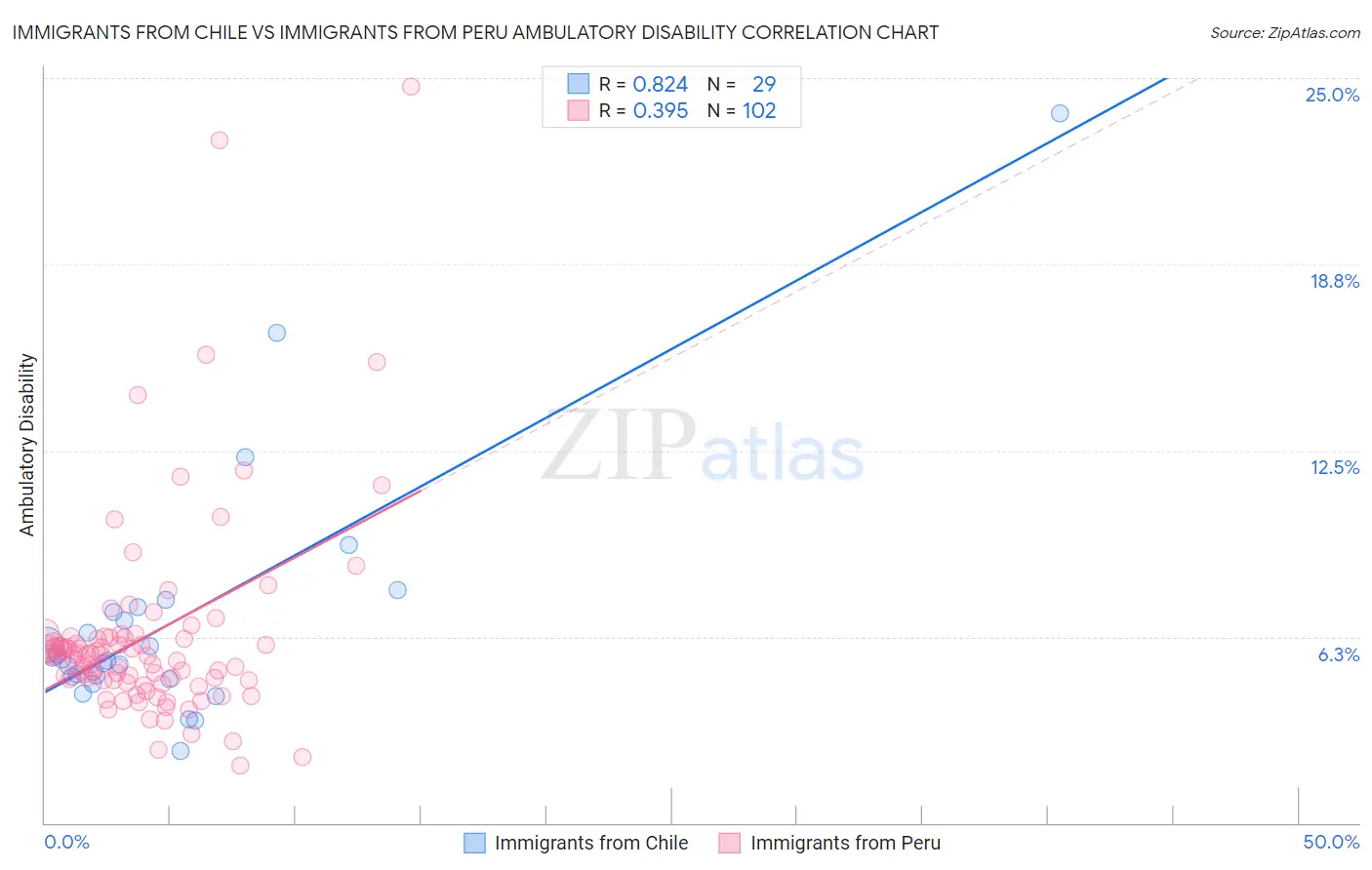Immigrants from Chile vs Immigrants from Peru Ambulatory Disability
COMPARE
Immigrants from Chile
Immigrants from Peru
Ambulatory Disability
Ambulatory Disability Comparison
Immigrants from Chile
Immigrants from Peru
5.8%
AMBULATORY DISABILITY
98.9/ 100
METRIC RATING
87th/ 347
METRIC RANK
5.7%
AMBULATORY DISABILITY
99.4/ 100
METRIC RATING
71st/ 347
METRIC RANK
Immigrants from Chile vs Immigrants from Peru Ambulatory Disability Correlation Chart
The statistical analysis conducted on geographies consisting of 218,629,833 people shows a very strong positive correlation between the proportion of Immigrants from Chile and percentage of population with ambulatory disability in the United States with a correlation coefficient (R) of 0.824 and weighted average of 5.8%. Similarly, the statistical analysis conducted on geographies consisting of 328,808,215 people shows a mild positive correlation between the proportion of Immigrants from Peru and percentage of population with ambulatory disability in the United States with a correlation coefficient (R) of 0.395 and weighted average of 5.7%, a difference of 0.81%.

Ambulatory Disability Correlation Summary
| Measurement | Immigrants from Chile | Immigrants from Peru |
| Minimum | 2.4% | 1.9% |
| Maximum | 23.8% | 24.7% |
| Range | 21.4% | 22.8% |
| Mean | 6.8% | 6.2% |
| Median | 5.5% | 5.6% |
| Interquartile 25% (IQ1) | 4.9% | 4.8% |
| Interquartile 75% (IQ3) | 7.2% | 6.2% |
| Interquartile Range (IQR) | 2.3% | 1.4% |
| Standard Deviation (Sample) | 4.3% | 3.4% |
| Standard Deviation (Population) | 4.2% | 3.4% |
Demographics Similar to Immigrants from Chile and Immigrants from Peru by Ambulatory Disability
In terms of ambulatory disability, the demographic groups most similar to Immigrants from Chile are Soviet Union (5.8%, a difference of 0.040%), Latvian (5.7%, a difference of 0.060%), South American (5.7%, a difference of 0.090%), Bhutanese (5.8%, a difference of 0.16%), and Ugandan (5.7%, a difference of 0.33%). Similarly, the demographic groups most similar to Immigrants from Peru are Brazilian (5.7%, a difference of 0.020%), Immigrants from Northern Africa (5.7%, a difference of 0.040%), Immigrants from Cameroon (5.7%, a difference of 0.040%), Sierra Leonean (5.7%, a difference of 0.090%), and Immigrants from South Africa (5.7%, a difference of 0.090%).
| Demographics | Rating | Rank | Ambulatory Disability |
| Peruvians | 99.5 /100 | #69 | Exceptional 5.7% |
| Sierra Leoneans | 99.4 /100 | #70 | Exceptional 5.7% |
| Immigrants | Peru | 99.4 /100 | #71 | Exceptional 5.7% |
| Brazilians | 99.4 /100 | #72 | Exceptional 5.7% |
| Immigrants | Northern Africa | 99.4 /100 | #73 | Exceptional 5.7% |
| Immigrants | Cameroon | 99.4 /100 | #74 | Exceptional 5.7% |
| Immigrants | South Africa | 99.3 /100 | #75 | Exceptional 5.7% |
| Sudanese | 99.3 /100 | #76 | Exceptional 5.7% |
| Immigrants | Vietnam | 99.3 /100 | #77 | Exceptional 5.7% |
| Somalis | 99.2 /100 | #78 | Exceptional 5.7% |
| Chileans | 99.2 /100 | #79 | Exceptional 5.7% |
| Immigrants | Ireland | 99.2 /100 | #80 | Exceptional 5.7% |
| Immigrants | Jordan | 99.2 /100 | #81 | Exceptional 5.7% |
| Palestinians | 99.2 /100 | #82 | Exceptional 5.7% |
| Eastern Europeans | 99.2 /100 | #83 | Exceptional 5.7% |
| Ugandans | 99.2 /100 | #84 | Exceptional 5.7% |
| South Americans | 99.0 /100 | #85 | Exceptional 5.7% |
| Latvians | 99.0 /100 | #86 | Exceptional 5.7% |
| Immigrants | Chile | 98.9 /100 | #87 | Exceptional 5.8% |
| Soviet Union | 98.9 /100 | #88 | Exceptional 5.8% |
| Bhutanese | 98.8 /100 | #89 | Exceptional 5.8% |